Reality of War
 |
German soldiers fighting in Novorossiysk, 1943. Pistol in one hand, ax in the other, ready for anything.
|
Sometimes pictures pretty much tell the whole story. Such is the case with most of these, though we've added some notes here and there just to put things in the context of time and place when that is known.
 |
| The officer in the middle has been wounded on his right hand/arm (note the blood stains). He is carrying a mp38, the two grunts have k98ks with buttplates. Highly doubtful this is a posed propaganda shot; in fact, the officer may be telling the photographer to scram. We see three return... but how many went out with them? (Federal Archives Koblenz No. 226/178/26a). |
The role of
exhaustion in warfare is almost never mentioned. Well, let's take a look, shall we?
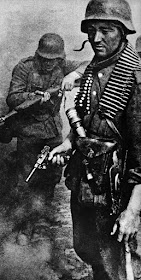 |
| Stalingrad. 1942. |
If you read standard histories of battles and campaigns, you almost never will hear about how the soldiers were worn out by marching to battle and thus lost, or for that reason didn't pursue a beaten enemy.
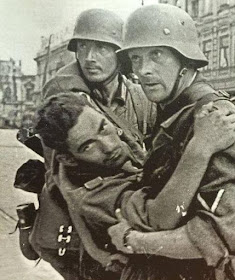 |
| Wehrmacht soldiers in Rostov trying to save a wounded comrade, 1942. Things are getting hectic and Stalingrad is just down the road. |
Then, the historians will say "General so-and-so missed a golden opportunity to finish off the retreating enemy." Many, many battles were decided by sheer exhaustion.
 |
| P/O Alan F. "Shag" Eckford, 21 years old, on 24 July 1940. This is the day he is posted from No 242 Squadron RAF to No 32 Squadron RAF at RAF Biggin Hill - one of the front-line units. Eckford is not a lazy slug; in fact, he flies three missions on the 24th, but in between, he does what fighter pilots do between missions. |
You will read that they won or lost, of course, but not how they savagely battled their enemy in hand-to-hand combat or simply became indifferent to just about anything through perpetual campaigning. So, they marched all night to get to the battle? Oh, might that have had something do with the fact they didn't pursue the enemy afterward and let them "get away"?
 |
| Waffen SS of Totenkopf Division aboard an Sdkfz 251 half track, apparently at Kursk after a hard day at the office. These were the elite of the Wehrmacht.... |
But that is the reality of war. It is not all shooting and heroes and Hollywood glamour.
 |
| "March 20km through the night so you can be in a position to hold a barren hill against a horde of murderous, fully rested, and better-armed killers." |
This page is about the small change of war. Ordinary grunts just getting through it. Sometimes, it isn't immaculate uniforms and people looking heroic. Men drive all night, then have to stop and wait until told to drive somewhere else. What would you do during the downtime?
War is bad food and mud and dirt and dust and boredom and the worst smells you will experience in your life, with momentary flashes of sheer terror.
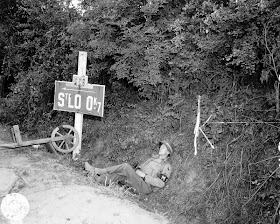 |
| Meanwhile, on the other side... This fine fellow probably would not have wanted his photo taken then. He better hope it was done by a friend and not his supervisor... |
It is as if soldiers were robots who recharged every night and went back to normal by morning, with every regiment always at a peak state of readiness and every army as mathematically powerful as the number of men in its ranks and the weapons they carry.
 |
| Soldiers in any army will recognize this - you've been hoofing it all day (note his mud-caked boots) and you get a few minutes to rest. Off you go to sleep sitting up. |
Men are not robots, however. Such is not the case and never has been. This is a collection of pictures of people who have been pushed as far as people can be pushed and still function at some level.
 |
| A boy sits alone in the ruins of his home, his parents buried dead underneath after a German rocket attack. London, 1945. Toni Frissell. |
This page shows both soldiers and civilians, because in World War II, civilians suffered as much as anyone, just in different ways.
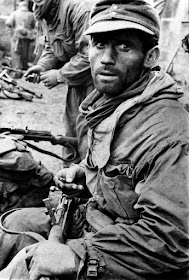 |
| Stalingrad, 1942. |
There are a lot of emotions expressed here, not all strictly exhaustion - here is a blind terror, stunned incomprehension, tragic sorrow, people beyond caring, dull incomprehension - and that is what we are getting at: people going through Hell.
 |
| This picture was taken during the advance into Russia. German infantry marched in the same fashion as Napoleon's men, 50 km daily average. They still could not keep up with the tanks, and headquarters wanted them to get as far East as possible. The intense pace and occasional strain of fighting produced exhaustion so that every moment of down-time was used for sleep. |
So if the title "exhaustion" is a bit misleading, well, it was as close as we could get. But there is a lot of sheer exhaustion, too.
 |
| Yay victory! Men of the First Marine Division coming off the line after twenty-three straight days of combat, Cape Gloucester, Jan 1944. But they got their flags. |
We don't know what all of these people have been through, what they saw only a few moments before the photograph was taken, whether they killed or saw others killed or simply were faced with an impossible situation.
 |
| Pilots dozing in the ready room - a common state of affairs in all air forces. |
It's the not knowing that makes many of the pictures so poignant. Their lives have changed - and they don't like it. But they're not sure yet just how much. The underlying theme is that these are people who somehow have survived, but more often than not probably don't much care anymore. That's what war will do to you.
 |
| An exhausted German infantryman takes a break between firefights in the necropolis of Stalingrad. He is weighed down by a backpack most likely containing all his belongings. His problem is food and ammunition, both in extremely short supply once the Soviet encirclement tied the noose. Shaving went out the window long ago. Oct-Nov 1942. |
We're not suggesting that anyone here does or does not deserve sympathy. They are human beings showing emotion, that is it. You will draw your own conclusions.
 |
| German soldiers on a hot day on the steppes of Ukraine, July 1941. Operation Barbarossa. It gets very hot as well as very cold out there. Guys like these do not show heat fatigue often - it has to be truly brutal for them to show weakness. |
Some of these folks know they're dead men. It's only a matter of time for them, as they are well aware. And there's not a thing they can do about it. The only questions left for them are when, and how.
 |
| Exhausted German grenadier somewhere in Russia, summer 1941. |
There are people who suffered more than these folks, died, were tortured, perished in the holocaust, were beheaded, are infinitely more deserving of remembrance and honor, and so on and so forth.
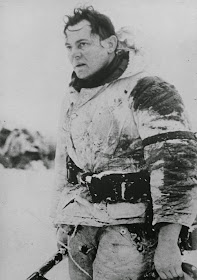 |
| This guy has had enough. |
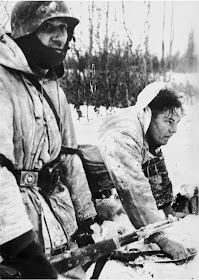 |
| Another picture of this guy and his buddy. The Finns were renowned as awesome irregular fighters, but they did not have the manpower to stage many pitched battles. |
Some of those other more-deserving folks no doubt were victims of some of the folks shown on this page.
 |
| 8th Panzer Division. |
We have pages for those folks, too. But this page is for that most natural of human states during wartime, tiredness.
 |
| Not a dramatic shot, but this is the reality of exhaustion in war - dirty, worn, in the middle of nowhere, emotionless, no patience for anything. On the Eastern Front, probably a dispatch rider, just an ordinary guy being passed on the road. |
These pictures also tell a side of the war that you will not often see. Why did the German invasion of the Soviet Union fail? These pictures help drive home that the answer, quite simply, was that the Soviet Union was big. It was huge. It was gigantic. Simply occupying the territory was a phenomenal undertaking, regardless of whether the Russians resisted. Of course, they did resist - but that was not the dominant factor in why the Germans lost. If it had been Poland or Czechoslovakia or Austria or any of those similar European nations (in terms of size), the Germans would have won. The Soviet Union was just too big. It wore the Germans out and exhausted their supplies of scarce commodities like oil and steel and rubber for tires.
 |
| German motorcycle troops during the opening stages of Operation Barbarossa. |
So, there is a point to all this in terms of outcomes. However, at the most basic level, this simply is a page showing in common human terms the misery and sheer tiredness a war can impose on everybody, whether they were wrong or right, good or bad, on our side or theirs. The Second World War.
 |
| Robert Capa, Omaha Beach, France, June 1944 A German soldier captured by American forces. |
 |
| Stalingrad: It is late November 1942. The Germans are surrounded. Leaves were canceled (land routes all closed anyway) unless you had contacts and the end was nowhere in sight. German morale was sagging and about to collapse completely as supplies ran low. If you were wounded, well, you could keep on fighting for as long as you could hold a rifle or you could go lie in a cold basement and maybe be fed scraps if someone took pity on you. The faces of these soldiers in Stalingrad, well, no more need be said. |
 |
| Portrait of a German Wehrmacht Oberfeldwebel following the Third Battle of Kharkov, which was a series of battles on the Eastern Front, undertaken by the German Army Group South against the Soviet Army, around the city of Kharkov between 19 Feb 1943 and 15 Mar 1943. The German counterstrike led to the destruction of approximately 52 Soviet divisions and the recapture of the cities of Kharkov and Belgorod. Kharkov Oblast, Ukraine, Soviet Union. April 1943. This fellow? Now he just wants to be left alone. Does he look relaxed? He's got his gun handy, you don't do that if you're feeling... secure. |
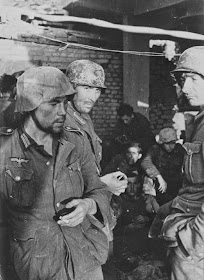 |
| Ordinary Wehrmacht soldiers in a basement in Stalingrad. They had to cower in basements to avoid shells and because they could stay warm down there. You dared not leave - someone would take your spot and you'd freeze to death somewhere not-so-warm The guys in the foreground are one thing - but notice the expressions of the ones in the background - the ones with the crazed eyes. Those are not happy men. This apparently was after the surrender. The Russians didn't have to guard them - they had nowhere to go. They may as well still have been armed for all the good it would do them. |
 |
| I knew a US Army Sergeant who served in Bosnia who looked exactly like the guy in the middle. Soldiers from the 17 Infantry of the German Wehrmacht recover after the street fighting in the port city of Rostov-on-Don, Russia, July 1942: German grenadiers take a breather during the street fighting. The Germans are fighting in winter uniforms despite the fact that it likely is sweltering out - they had learned their lesson. Note the satchels full of stick grenades, the indispensable weapon in street fighting. It is still early in the war and the soldiers are mature men, veterans of previous campaigns. By 1943, this age cohort had been decimated. They don't look... happy. In fact, they look dazed and confused. Do you think they want to be there? |
 |
| 1945: a young German girl cries in the ruins of a bombed-out building after losing her entire family. |
 |
| French Resistance fighter, Paris, 1944. The partisans staged an uprising - then waited days for the Allied troops to arrive. The relief troops ultimately did arrive, unlike in Warsaw shortly thereafter. |
 |
| Sailor sleeping just inside a hatch on board the battleship New Jersey while en route to the Philippines, December 1944. Life of a sailor, too tired to make it back to his bunk. |
 |
| Stalingrad POWs. They're all dead men. They know it. Think he'll get new spectacles if his break? |
 |
| No, he's not dead. This is a Red Army soldier who, desperate from thirst, drinks water from the cooling tank of a disabled Maxim heavy machine gun. Believe me, he's thankful to get it. Summer 1942. |
 |
| German Paratrooper. The eyes tell the whole story. Picture him in a horror film - it's easy to do. |
 |
| Albert Speer, Minister of Armaments, sitting on a doorstep, 22 Dec 1942. A real shot, not posed, this is an incredible shot for a top Party member to allow to be taken. This was during the siege of Stalingrad, 300,000 trapped men dead or dying, and he had nothing. He is vilified today by many due to slave labor issues. He studied to be an architect. He wanted that, nothing else. Then he met a man named Adolf Hitler (Ruge, Federal Archive). |
 |
| In the last days of Germany, the SS pressed into service children as young as 10 and 12 years old. Two of these young recruits figure in this photo wearing the peculiar fireman's helmet. Some of these children even participated in roving firing squads shooting deserters and others the SS deemed "traitors." |
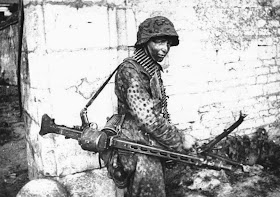 |
| That's an impressive shot. Normandy, 1944. |
 |
| Berlin May 1945. Many in this situation just grabbed a pistol.... |
 |
| At least it's all over. "Thanks for everything, Adolf." |
2021







































Brilliant!
ReplyDeleteHow dare you
ReplyDelete